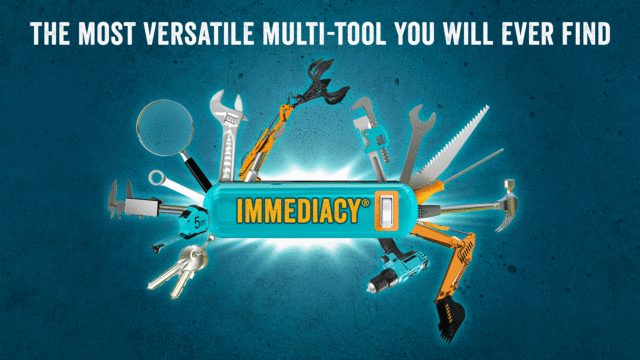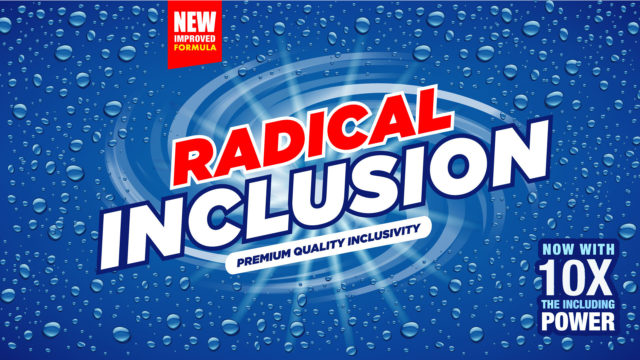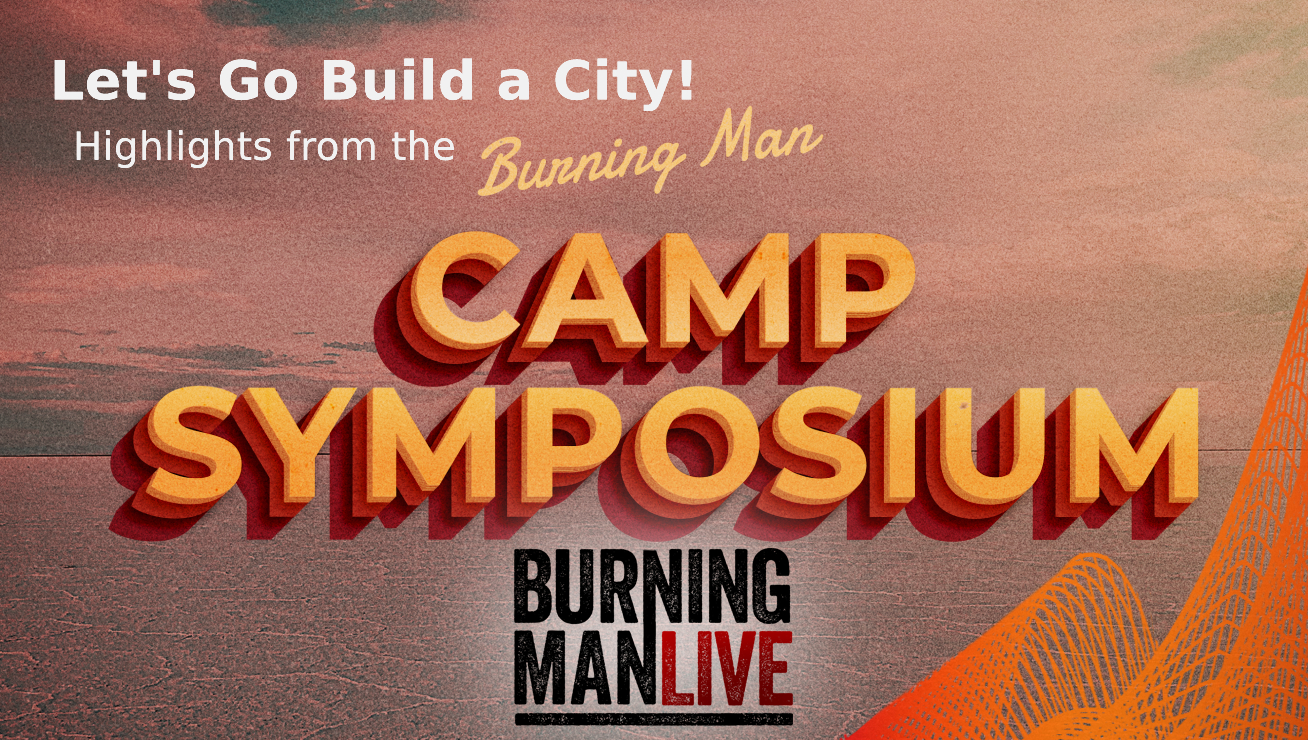
Lets Go Build a City: Camp Symposium 2023
Most people in Black Rock City live together in placed camps, aka theme camps, the most unique aspect of a most unique event. There are almost 1300 camps in BRC.
The annual Camp Symposium brought together dozens of staff and volunteers to talk out what they do to gift their interactive camp to BRC.
Hear (or read) highlights from the Plenary, many voices sharing knowledge and exploring ideas.
Bryant Tan, aka Level, Associate Director of Placement, and a spaghettification of speakers:
- Breedlove: Director of Civic Engagement
- Charlie: Director of Event Operations
- Claire of the Green Theme Camp Community
- DA: Environmental Restoration Manager
- Marian: CEO of Burning Man Project
- Trixxie of the Placement Team
- Yeti of the Camp Support Team
Here is how to
- enjoy Leaving No Trace
- make frameworks for leaders
- build boundaries of community
- hold a center for our cultural vision
- make sense of mysterious acronyms!
“We build the hive, they bring the honey.” ~Larry Harvey
Camps and Placement | Burning Man
Cultural Direction Setting & Decommodification
Placement: About Us & Volunteering
Camp Support Team | Burning Man
Waking Dreams: Evoking Greener Burns
Leaving No Trace 2022: MOOP Maps, Inspection, and the #1 MOOP
Charlie Dolman · The Dust is in the Details (Burning Man LIVE 2022)
Dark Angel of Black Rock & Restoration Destiny (Burning Man LIVE 2020)
Why People Dress Funny at Burning Man (2003)
Peter Doty Obituary (San Francisco Chronicle)
Transcript
STUART: Hello, my friends. Welcome back to another episode of Burning Man LIVE. I just love saying that. I’m Stuart Mangram. I’m here with my friend Vav. Hey, Vav.
VAV: Hey, Stuart Mangrum.
STUART: Hello, Vav-Michael-Vav.
Today we have an episode that we’ve put together from an event, that, if you missed it, you missed a lot of great information. If you’re interested in camping in Black Rock City this year, we have a whole symposium, well, for what we call the placed camps. We used to just call everybody theme camps, right? Where did that even come from? What is a theme camp, Vav?
VAV: A theme camp is a bunch of zealous people coming together to create something interactive, something dynamic and interesting. It’s a labor of love, an elaborate gift to everyone else on the playa.
STUART: Yeah, and it’s really what makes our city what it is in a very real way.
VAV: Theme camps are really one of the most unique aspects of Black Rock City and the Burning Man culture compared to other large gatherings around the world.
STUART: That is true. And we have over a thousand of them now. Wow. Head exploding noise. Cue the head explosion please.
I’ve been in a few. How about you? Before you became a staff member, were you a theme camper?
VAV: Yes, I’ve created a couple of theme camps and mostly just enjoy them. I can’t really stumble from my bed to the porta potty without getting distracted and somehow pulled into somebody’s theme camp, and come back later with stickers or stamps or a full belly, and be glad that I left my bed.
STUART: Yeah, it seems like they’ve been there forever. Have they been there forever? What was the first theme camp, Vav?
VAV: Tiki Camp, early nineties?
STUART: Good answer. Preaching to the choir, here. I like to think it was. We had generator power, we had shade, we had ice, we had tropical drinks with little paper umbrellas in them. I think it was the first real camp, but before that, well, there was Christmas Camp the year before, in 1996.
VAV: Christmas Camp is hilarious because it’s very hot, and yet you’re wearing winter hats.
STUART: Ho, ho, ho. And, Creepy Santa wants you to sit in his lap and drink eggnog. It was a prank more than a camp, but it was a magical prank. That creepy Santa Claus, sadly, we just lost him. His name was Peter Doty. He was a stalwart of the Cacophony community. He was a giant among pranksters and fools, and terribly missed.
And Christmas Camp was not the first camp. The history gets a little hazy, but apparently in 1990 there were at least two camps that, today, people would look at them and go, “Yeah, that was a theme camp.”
One of them was the Modern Primitive which was Kevin Evans and Seb Hyde and the so-called Art Babies, covering themselves in mud, made their own language, made their own money out of clay and traded it for home brew. If you went to their camp, you would get to talk gibberish and maybe get a home brew.
And Ms. Vivian had a camp which people retroactively refer to as Posh Camp because her schtick was having complete luxury on the playa. Everything was silver and crystal, and she had an outfit out of black velvet that she brought like four of them, so that she was always immaculate and never covered with dust.
So those are some of the seeds of theme-campery. Today we have over a thousand, when you tally in all the mutant vehicle camps and the art support camps and so forth, I get, is it 1300?
VAV: Yeah, almost 1300.
STUART: The vast majority of people who camp in Black Rock City are camping in one of these communities.
So over the years the Burning Man Project has, I would say, we’ve grown our ability to support them. We used to have an event called the Theme Camp Forum. It was basically a half a day of every department in the organization standing up and lecturing people on what not to do: Don’t leave your trash. Don’t do that.
It has blossomed into an amazing daylong event called the Camp Symposium, with all the content programmed, not by Burning Man Project, but actually by volunteers, by the Camp Support team, which is part of the Placement crew.
So, it’s very much a co-learning experience at this point. And, it’s still got some preachiness to it because people need to hear things like, how did our MOOP process go last year? You know, are we gonna get our permit renewed? And all that. But it’s also an opportunity for a lot of peer-to-peer co-learning.
What were some of the things that people were co-learning about this year? What were some of the hot topics, Vav?
VAV: A lot of people talked about Green Theme Camp Community and the BLAST Certification and the Thrival Guide.
STUART: So sustainability was huge this year for obvious reasons, and every year people want to talk about basically herding cats, right? How do I get all of my friends and volunteers to show up and do the things that they said they were going to do when they’re enticed by a shiny thing somewhere else?
Lot of great learning going on. Standby. We’ve got a highlight reel. Whether you camp in a placed camp or whether you camp in a little pup tent out on your own, out in the quiet zone, there’s a lot of good information in here. So if you’re planning on coming to Black Rock City this year, stick around and listen to excerpts from this year’s Camp Symposium.
Spin it, Vav.
LEVEL: Good morning. If it’s morning where you are, Black Rock City. Welcome to the 2023 Camp Symposium. My name is Bryant Tan, better known as Level. I am the Associate Director of Placement in Black Rock City.
We are here to bring together the Theme Camp community, Art Support camps, Mutant Vehicle camps, and Burning Man Project staff to share our knowledge, support one another, and provide you with really important information about how this year’s going to go.
So, we want to hear how other people are coming to the table, how other people have burned, and see what tips we can take from them.
2022 was a big lift. I know that we took two years off and didn’t do Black Rock City and we went out there again. It was really dusty. It was really hot. And we acknowledge how much of a lift it was for all of you to make that happen again. Thank you so, so much.
And we’re gonna do it again. 2023. Here we come!
I’m gonna pass it on to both our CEO and our Events Operations Director, Marian Goodell and Charlie Dolman.
MARIAN: Good morning. I am so, so, so, so, so happy to be here, and to look forward to what 2023 has, how you can show up and be a good citizen, how you can help your campmates be good citizens. What I really appreciate about this symposium is: this is the place that any campmate can come, or any camp leadership can come, and look at what’s the landscape of what’s in front of us for 2023. What are the expectations from the Placement Team? What are the expectations from the culture? What are the expectations from the community? This is that source.
Also, like Level, I’m so grateful for everything that people bring to Black Rock City. From my own experience, organizing people, or cats, towards a goal is one of the hardest things to do and one of the most rewarding things to do. So those of you in these leadership positions, managing your friends, really, usually, to build a camp and bring your camp and your group and your fun to Burning Man, that really is incredibly hard. I’ve pounded in T-stakes around the fence, and I believe, from my own experience running my camp, that running a camp is harder than pounding T-stakes in the fence around Black Rock City. Right, Charlie?
CHARLIE: Yep.
MARIAN: Charlie, you’ve been part of a camp leadership too.
CHARLIE:. I have. I was, for many years before working here. Hard.
MARIAN: It is, it’s like producing mini events in these mini groups. And so we are grateful and we really recognize the work you all are doing. And the work that Level and the team do. They’re very considerate and they’re very thoughtful and they think really hard about the work that you all are doing.
And, part of what we do also is to help create a framework. And I think some of the important things that you’ll get to experience today is some of the narrative that is slowly changing for the better. We’ve gotten a lot of feedback from you all. We’ve heard about how you’re really demoralized when other folks violate the rules year after year and what are we doing about it?
You’re also gonna hear a little bit about how, I think we need to level up a little bit, around Decommodification. That’s the slipperiest slope. We have an opportunity to really – as leaders of our groups and our camps – take some responsibility for who we have in our camp and are they following the rules?
We definitely saw an uptick again of people branding their experience at Burning Man, showing off with photos of branded bikes, branded clothes, and we really need to turn to you guys to help stop that. I’ve had campmates before that did things that didn’t belong in our community, and I’m the one who blocked having them come back to my camp.
So, it’s up to us as leaders in the community to help hold the center for our culture. And I’m really proud of the work that some of you participated in with Level. I think there ultimately were 80 people, part of Cultural Direction Setting, and that’s still a guiding light for us in the organization and for Level. For the team and for Charlie, and many of the decisions that we’re making and, and many of the people that you’re gonna hear today, when we weigh carefully how it is that we’re gonna manage the rules and the boundaries and the community, it really is being driven by the Cultural Direction Setting.
So, I just want to thank you. You know, it was a tough year last year. I believe that it can’t get really any tougher, and we know what kind of stock we’re made of when we go to Burning Man. It’s a new horizon. And also, as you all drive through Gerlach, I think you could be really proud of the way in which the organization is becoming a steward of land in Northern Nevada. And some of the programming that we’re doing in Northern Nevada is gonna support theme camps. Of course there’s a storage program, and eventually there’s gonna be Maker Space. And so, we’re in it with you guys and we’re here to support you. Charlie?
CHARLIE: Well, it’s exciting, isn’t it, Marian, to be getting back again? I, for one, deeply felt the not-going-back-to Black Rock City as a break in a well worn cycle; It just didn’t feel good. You know, Marian, thank you for calling out that all of the people on this call today are ambassadors of the culture. Really that is the piece that the world sees from what we do. How the culture manifests is what people take away from our community, what they imagine our community to be. And the decommodification aspect of things, kind of out in the world and on the internet, is a very visible piece.
Because my lens is operations, I kind of also think about it in terms of the actions that we take and the things that we do on the ground. And 2022 was a hard year. MOOPing was harder last year than it’s been in a while. DA’s gonna talk about this, but we came closer to failing our test than we have ever, ever, ever done. It was skin-of-our-teeth moment. You know, Exodus didn’t go particularly well, but there were people fighting in the line of Exodus. That’s not great. There was a lot of speeding in Black Rock City and the e-bikes have made that super easy and very tempting.
You know, all of these behaviors that we model in Black Rock City are us expressing how we are with each other, and that behavior manifests the culture. So, as we think about taking care of the culture and modeling it for how we want the world to be, all of these little details really, really matter.
As an organization, I own that we made mistakes last year and things were not easy for us. There’s other wrinkles that we need to kind of work out. Um. And we are working super hard to do that. And the invitation and the request is that we all look at the bits that we can work on and that we can improve, and so that we can be the best ambassadors that we can be, and that Black Rock City can be the best model that it can be for how the culture can manifest itself. I’m excited about that.
I feel really good about the moments that we’ve had to learn from last year and the opportunity in front of us, and the people that are joining us, and today is a great way to get that ball rolling. Have those conversations, open those doors, and find those allies in doing that work. So, yeah. Thanks, Marian.
MARIAN: I’m all for it, Charlie. I’m glad we’re here. And folks, just give us your inspirational reasons: Why do you do it? Why do you take all the time to gather all the ducks and the cats in a row and do your playfulness at Burning Man? What’s your inspiration? Help us be inspired about why you do it. We’ll share it with the rest of the staff, cuz we get a lot of inspiration from you all. Thank you so much, Charlie and Level and everybody.
LEVEL: Thank you, Marian.
CHARLIE: Thank you, Level.
LEVEL: Thank you, Charlie! I know how I would answer that question. I remember before I started going to Burning Man in 2009, I was like, I really want to go to the, check out the art – looks like art school. And then what kept me going back was the people, in realizing there are some amazing, amazing people in Black Rock City. And, you know, we talk about the potential of what people can do, if we just all come into the right spirit, and under the right principles, and it blew my mind. And so anyway here, I just feel so honored to be able to keep doing that and herd all the cats that we get to herd in Placement, which is all the theme camps.
Thank you so much Marian, Charlie. They are battling lots of battles and trying to smooth a lot of things out. So I really appreciate your leadership in all of this.
CULTURAL VISION, SUSTAINABILITY, R.I.D.E. & CAMP EVALUATIONS
LEVEL: Yeah, it was hot and dusty. I had noticed that people appreciate the acknowledgement of all of that. We were all out there together, so I really appreciate how much people really stuck it through, and all the sweat that was required to even just break down your camp and try to keep people’s morale up.
I’m gonna switch gears a little bit. What we wanted to do was share with you all trends that are happening in Black Rock City and also approaches that we’re taking. Sometimes I think folks don’t hear enough about what’s going on in the background. You’re all planning and organizing your own cats to do the thing. And in the background, we’re also trying to see: Where can we add value and support you all better as well as preserve our culture more? And so this is a little bit of a state of the union address for camps and Placement in Black Rock City 2023.
There’s four main things that I’ll be covering.
First is moving towards our cultural vision.
Next is about sustainability and R.I.D.E..
After that I’ll talk a little bit about camp standings and evaluation.
And then finally, end with managing growth and limits.
So these are the four big topics.
As you all hopefully know, Cultural Direction Setting was a project that we launched in 2018. It went on for a couple years in a really intensive state. Obviously between 2020 and 2022 we didn’t have the event. But this was a cultural reset. It was saying, what do we envision for Black Rock City in the next 10 years? How do we want theme camps and the community to show up? What are the standards and expectations that we’re gonna have of them?
And also, unpack the Placement process. We heard a lot about people wanting Placement to be more transparent; to be able to see your Placers more than just that time you meet them on playa; to have a clear understanding of what we’re looking for when we’re deciding about Placement. And so all of those things are happening. I hope you all see the actual outputs of that.
And it was a really big moment to say, “Let’s pull together” — Marian mentioned earlier — over 80 people to think about “What can we do as a community to show up in Black Rock City?” especially as new people arrive as well.
We’re also continuing to support sustainability and R.I.D.E. Sustainability is about trying to get to a carbon neutral place, but actually also trying to get to a carbon negative place, so helping camps think about what are the resources? What is the energy that is required to get you out to Black Rock City? And how can we, when we’re there, really have the lowest carbon footprint possible?
We started a process called HUBS last year: Humans Uniting for Better Sustainability. It’s our sharing system where we ask camps to partner with each other beforehand and let us know and we’ll place you all together. We’re also looking, really, at power and waste. What are the energies that’s required? Are you all bringing generators out? Are more people using solar? Are you actually just decreasing your need for power? As well as waste systems and thinking about composting and regenerative practices?
And R.I.D.E. is Radical Inclusion, Diversity and Equity. We continue to want to diversify the community and uh, building a seat, for people of all backgrounds, to be in Black Rock City, to be a part of your camps, as a big entry point for people. And how are people feeling when they’re roaming the city? This is not just about diversity. It’s about welcoming people and helping people feel like they belong, whether or not they look like you, whether or not they are into the same music type you’re into. And inclusion and belonging is another big area of work that we’re hoping camps join in on. And we recognize that it’s an ongoing process. This is not something that happens overnight. We’re trying to build more tools and more conversations around it.
So the last section of this, this is the meatiest part of what I wanted to share. We wanted to talk about camp standings. Marian mentioned earlier, preserving our culture. We want to let people know there are active ways that we are doing this. I think sometimes people think that there’s a black hole of information, and like, people report things that they might think are funny, and feel like it goes nowhere, but it actually does go somewhere. We want to do a better job of explaining that. So here’s a first attempt.
First I want to let folks know: reports matter. When you see someone or a group of people doing it wrong in Black Rock City, we do care. We both care at the event, but also year round. So there’s a few emails here that you can always contact. There’s DoingItWrong@burningman.org. There’s IP@burningman.org, and placement@burningman.org.
Each of these has a different group of people catching it, and I want to show you what we do after we catch that. If there’s things that come out, before the event, please, if you have evidence of it, if there’s a screenshot, if there’s anything that you can share, rather than just hearsay, that really helps build a case for us.
How we respond when we see these things: We first investigate. We try to get all sides of the story and understand what’s going on. And we review like, “Who is that person? Is it someone that’s a known member of the community? Is it someone new?” Someone newer may not understand how things work as well. And so we definitely try to understand the history and background of them. And then we approach the person or the group of people, and say, “Hey, let’s have a conversation. What was your motivation here? Did you understand that the 10 Principles exist? Did you understand Decommodification?”
And then we also provide an opportunity to improve. And I think this is a really key one. I think that a lot of people like to go and say, “Hey, you’re doing it wrong. Slow down. It’s five miles per hour,” or “You’re doing it wrong,” whatever it is. We want to help people improve. We want to help people learn. We want to help people have more than a first chance to get it right. And so I know that there are some camps out there that people are like, “Wait a minute, why do I keep seeing them coming back year after year?” And that’s because we do give an opportunity to improve and we do ask them to come up with improvement plans and try to figure out supports for them. That’s a little bit about our process.
Next: On playa, you can report things, and in real time. We just built a Placement office last year at 5:59 and Esplanade. please feel free to come there. We do have staff there that can take reports in. You might notice that a mutant vehicle or a camp is asking for wristbands to enter their space. You might see extreme MOOP and disregard of picking up after themselves and disregard of any of the other 10 Principles. You might see a commercial photo shoot, you might see brands being plastered and people shooting commercials. Please report all of that. There’s also other things, but those are just a small sample of what we are looking for and what we do act on.
We’ve developed all these processes over time as we learn about how to do this in a way that feels just and fair. But after every event, we do have an interdepartmental summit that happens where many Burning Man departments come together. We share data, try to figure out, is there a triangulation of information? Are there patterns?
If there’s a problem, we’d also recommend a course of action. And then we also determine a standing, which you all should have received if you were placed in Black Rock City last year. We have a standing system, where good standing means camps are good to go. You’re eligible next year to be placed. You’re also eligible for Steward Sale tickets. Limited standing is about limiting some aspects of the camp. There might be some things that have gone awry. There might be some cultural challenges, but not, anyone that we feel like is a lost cause. And so we might limit. Often what we see is camps grow and they lose a handle of their community. And so we encourage them to shrink, and then sometimes we have to force them to shrink.
Then not good standing: We sort of tell people to go back to Go; you start the round over. You have to rethink how you operate your camp. And we sometimes ask people to take years off. And to note, Art and the DMV are also doing something similar.
So for 2023, a big stat that I wanted to share with you all is that there were 1,204 good standing camps. This is the real headline here. A lot of people think that there’s a plug-n-play on every corner of Black Rock City, and that is not the case. What we want to do is actually be more transparent with you all as we move forward to say, what are the numbers every year?
- 1,204 good standing camps.
- 22 that were limited standing.
- 16 camps in not good standing.
Again, in the spirit of improvement, in the spirit of believing in people, we don’t necessarily just come up with a verdict immediately. So there are 16 that received warnings. But by and large the lion’s share is doing great.
I mentioned this earlier. We do have, progressive actions that we do, anything from warning, to offering coaching, to dis-invitation to the event. And then the final one is: naming bad actors publicly.
Sometimes there’s camps or groups of people that do it so wrong that we want to make sure they’re not continuing to sell themselves, and people unknowingly join those groups. They have been disinvited from Burning Man for the next three years. And like I said, they’re going back to go and restarting.
The last point that I wanted to make was we are managing growth and limits in Black Rock City. In 2010, Placement used to place in these petal patterns, and open camping even existed up to A and B Street. That has completely changed. We actually place over 90% of Black Rock City, and we’re at our limits. We really do want to preserve open camping. And so this is a conversation that we want to open up with the community. There isn’t unfortunately space for everyone, and because everyone’s doing great – there are 1,204 in good standing – it becomes increasingly difficult for us to figure out how to manage all this. And I think some people felt a little pinched this year with Steward Sale tickets. We want to hear from you all and figure out how to resolve it together.
That’s the state of Black Rock City Placement and camps in 2023 from a little bit more of a macro level. I hope that you join the conversation. We never want to make decisions in a bubble without community input or without community leadership. We look forward to this conversation.
I’m gonna switch gears a little bit now, and we are gonna go to Sabrina. Yeah, we’re gonna do some data. So Trixxie is a wonderful addition to the Placement team. We sit on a lot of data. As you all know, you provide that data through the Placement questionnaire, through the post-playa reports, and we want to share some of that back with you. So take it away, Trixxie.
TRIXXIE: Awesome. Thanks Level. And you really kicked off a lot of the conversations that we’re gonna have in talking a little bit about the touchpoints that we have throughout the year where we get data from theme camp leads like you. Everyone just filled out their statement of intent and right now we are all thick in the midst of filling out the Place Camp questionnaire, although I think there’s 600 camps who’ve already finished. So I’m like very jealous because y’all are on top of things.
And then Level really went into the opportunities to give feedback, or even report bad actors that happen on playa itself, through the Placement office, through peers, through your actual sector Placement or through other departments such as Rangers, Resto, PETROL, etc. Then after the burn, then we have two opportunities for you to give feedback as well, which is the post-playa report and then also the Neighborhood Interactivity survey. And this year, as Level pointed out, we gave you the standing snapshot, and then in that report we gave you some data and some feedback. So what I’m gonna do is dive into some of these data sources.
The very first one is the post-playa report. We asked all theme camp leads to reflect on their camp’s experience and then rate themselves (these aren’t ratings from Placement; these are your own self ratings on how you did) in 10 different categories.
What I want to point out is the bottom two, which is foot and bike traffic, which very well might be for the rough roads, and we’ve all talked about how difficult of a year it was, but also I want to look at the top one: Leave No Trace, which was the top rating of all of these 10 categories. On average, camps rated themselves as a 4.7 out of 5 for LNT. Now we’ve all heard that it was maybe not the best year for MOOP on playa. So I was really interested to see if all camps rated themselves this high in LNT or if there was differences in different sectors, sizes, etcetera.
When I drilled down into size, that’s when we started seeing some trends. And on average the smaller camps were rating themselves more positively in their LNT efforts. And then as we got bigger and bigger in size, that’s when we started seeing camps reflect that they maybe didn’t do as well as they should have done, or could have done in LNT. So if this is resonating with you, I know that there’s gonna be a lot of talk about LNT and also DA is gonna be talking about Resto, so kinda keep this picture in mind when he’s talking later on.
The next up is the Neighborhood Interactivity report. So unlike the PPR, which was only theme camp leads, this was open to everyone. We wanted all Burners to give us feedback, and we asked them what their three favorite camps in Black Rock City, and then asked them why. Of all the 747 camps that were reported to us about being a favorite camp, some of them got fantastic reviews and fantastic comments. And in your standings report, we tried to reflect back to you the wonderful things that we heard about your camp. Remember, being someone’s favorite camp had absolutely no effect on your standings. This is just feel-good data. And we hope that if you got that information in your standings report, it made your day just as much as it makes our day on the Placement team reading it. And if you weren’t someone’s favorite camp, note that there were 93 favorites that we got in the survey that were obscure, like “I love the camp on the corner with a purple couch.” As much as we tried, we could not identify which camp they were talking about.
On the flip side of things, we talked about favorites, and now let’s talk about the things that people didn’t like. So the most frequent complaints that we are getting from all of the camps about unneighborly behavior is really having to do with sound or noise. What I would love for all of us to do is when we’re thinking about our next year, have that conversation with your campers, and what is the tension that exists between wanting to play the music we want to hear, when we want to hear it at the volume that we want to hear it, and then also being a good neighbor.
And then the last piece there is increased demand for not only camps to participate in Black Rock City, but also tickets. So comparing last year to this year in the statement of intent, there were 13% more camps who wanted to join, as well as 17% more tickets requested. So 35,000 tickets were requested in just the Steward Sale tickets. And so on behalf of Placement, for those 52 camps who actually requested fewer tickets in their steward sale allocations, I salute you.
Back to Level.
LEVEL: Thank you, Trixxie. And thank you all for just being honest and open with us. You’ll see that some of what we’re dishing out today is really based on these thematics and trends that we’re seeing.
MOOP, LEAVING NO TRACE & A NEW ASK OF THEME CAMPS
LEVEL:
You know that just made me realize. We do something so crazy. We build a city out of dust with amazing art. We burn shit. Part of that effort is about Leaving No Trace. Alright. We’re gonna bring up DA, Dark Angel of Black Rock City. DA. Take it away. Tell us how we did in 2022.
DA: Yeah. What’s up, Black Rock City? I love you guys. Oh. Woo! Leave No Trace! What can I say about 2022? You know, this was not our cleanest victory, but it was a victory nonetheless. This year was hard. I know it. I was there with you guys. That 110 degree heat all week with those blinding dust storms that were choking us out and burying our MOOP at the same time. And then the fatigue set in, and the next thing you know people were bailing. And it was really interesting looking around towards the end of the event. From my perspective, it looked like most people had left by the time the event ended. And then also a few days later, it looked like the most people I’d ever seen were still stuck on the playa. The fact that both of those things could be true in the same year, it was like, “Okay, here we are. We’re struggling.” But we did it. We returned to the playa and we left no trace.
And the power and the future of Leaving No Trace is really, and as it always has been, in the hands and the power of our collective community. And as we raise the level of our collective leave no trace effort, we can keep building and burning wherever we go. It’s how we got here. It’s how we got from a few hundred people out in the Black Rock desert, to towards 80,000 people.
We are gonna be doing this again and headlong into the playa. So the Leaving No Trace principle. We’re gonna go over this, back to basics. “We are committed to leaving no physical trace of our activities wherever we gather. We clean up after ourselves and endeavor whenever possible to leave such places in a better state than when we found them.”
Now we’re gonna talk about MOOP. Matter Out Of Place. MOOP is anything and everything that isn’t natural to the immediate environment. Our environment is the Black Rock Desert, aka the playa, where there’s nothing but dust, so MOOP is everything.
All right. Top MOOP in BRC Countdown. Here we go.
6. Metal debris: screws, fasteners, nuts and bolts
5. Glass debris
4. Plastic debris
3. And coming in at number three is the former heavyweight champion of MOOP: wood debris. We are making some progress on the wood debris front. So good job with that.
2. Now up to number two, assorted matter out of place. This is just a little bit of everything. It’s an assorted bag.
1. And so here it is, the new #1 MOOP in Black Rock City is, and it’s a doozy: Tent stakes, rebar, spikes, lag bolts. This is the most dangerous MOOP. These are tire poppers. These are dangerous. The amount of tent stakes was about a thousand. We have to own this. And we need you guys to account for everything that you put into the ground, especially tent stakes, rebar, lag bolts. If those lag bolts are going flush into the ground you need to tie a marker off so you know where it is, or you flag it. But just make sure that you account for all of them.
We share the Black Rock Desert. It’s our responsibility to leave no trace. I understand that the dust has come in and it’s come in to bury our MOOPs and it was hard for us to find, but we need to account for it. There is no excuse. We’re moving on, and we are gonna bring this number down.
So, you may have also seen that we are now pushing out an alternate version of The MOOP Map, which is the clear version. And quite simply, it is much simpler to focus on the MOOP when you look at the clear version. It is red and yellow. This is where the MOOP is, as opposed to our eyes being distracted to where the MOOP isn’t, which is often what happens with green. And green is a beautiful thing when we see it. But when you look at it this way, you can really see where MOOP was happening and where we need to improve.
It is the same exact data as the traditional green MOOP map.
- Red is stop, difficult progress, MOOP recorded.
- Yellow: caution, moderate progress, some MOOP recorded.
- Clear. Keep going. Forward progress.
That doesn’t mean that it was perfect. It means it is not breaking our stride. We are moving. So if you’re striving for green, go for green. That’s really great. Do not lose sight of the MOOP. Okay?
And here are the results of the inspection. The Bureau of Land Management site inspections conducted one month after the Burn. The allowable MOOP standard is one square foot per acre. So you imagine a football field without the end zones. Black Rock City is 3,603 acres, that’s 3,603 football fields, or 156 million square feet. That’s a lot of square feet, and that’s why your cleanup effort means the world to us.
The inspection report says that we are required following each Burning Man event to clean up the playa such that less than 10% of all post-event inspection points contained no more than one square foot per acre. That means if we have 120 test points, we are not allowed to fail 12. That number is not a lot. That is a new stipulation on top of our one square foot per acre, and this was a direct result of the environmental impact statement that the BLM wrote for Burning Man back in 2019.
What a BLM test point looks like. Nail a stake into the ground, tie off a 38 foot rope and line up. And then you MOOP in a circular radius, and you put it all in a plastic bag. And this year was close. And then that MOOP is actually photographed over a green screen and the pixels are counted. And this is how they figure out the percentage on whether we passed or failed.
We are not allowed to fail 12 test points out of the 120. In 2019, we only failed one. That is a practically perfect score. And in 2022, we failed eight. We failed eight. But there were plenty of bags that were very close to the margin. So this number could have very easily… It’s a game of inches, and going from eight to 12, that could have happened real quick. Being at eight, honestly, is for us, and especially knowing how MOOPy it was, we passed by the skin of our teeth this year.
If there’s any good news, it’s that we were on average able to keep the MOOP down. In 2019, we were at 0.2 square foot per acre. And in 2022, we are at 0.4 square foot per acre. So that’s a bit of good news. We fought hard to get that result. But it’s that 10% — ”Less than 10% of all post event inspection points contain no more than 1 square foot per acre” — that’s the one that’s always looming over this standard now.
Here’s some of our advice.
- Daily morning MOOP sweeps. This is, again, the power of your community. You guys have hundred people, 200 people in your camp get 15, or more, to do MOOP sweeps every morning for 15 minutes. If we do a little bit every day, that makes a massive difference. That is MOOP that you will not have to dig and find at the end of the event. Now this could be a different 15 people. And this could add up to 100 at the end of the week. And what’s good is that your MOOPers will start developing the language and they’ll start seeing where MOOP is and what the trends were, which will aid you guys when you start making your own MOOP map.
- You guys are gonna be MOOP mapping your own camps. I want you guys to know what your impact is and where it’s going to be. This way you know what’s up, and we know what’s up, and we can talk when it’s all said and done and just say, “Hey, you’re accounting for this.” You know that the impact’s gonna be the burn, or the bar. or the potties. So you’re gonna be anticipating it and you’re gonna be marking your own MOOP map. And we’re gonna compare notes.
- After you strike your camp, then you MOOP sweep again. And this is where you need again, like you’re 15 or so MOOPers. Ideally you could stretch out the width of your camp six feet apart or arms’ width apart. You’re gonna be MOOP sweeping after the strike. Do your best to try to get all that stuff off the playa. Just have your MOOPers there and MOOP sweep your camp.
- And then you’re gonna be using the BLM inspection method to MOOP test your camp. I want you to stress test areas that you know are gonna be MOOPy or that took an impact. So whether it’s your dance floor, or it’s your kitchen, or the showers or any of those places, test yourself. And what you’re gonna do is you’re gonna nail spike into the ground. Don’t forget to pull it up at the end! Nail a spike into the ground. Tie a 38 foot rope, and you’re gonna MOOP the radius with your MOOPers. And basically, if those results are bigger than the palm of your hand, you fail. And if it’s less than the palm of your hand, you pass. But you’re not gonna be measuring MOOP at that time. You just want a general idea. So you’re gonna be testing yourselves and we’ll be putting more information out on how to do this, but you get the idea.
- And then Leave No Trace and get the hell off the playa. Boom. Let’s get outta there.
Stand proud. BRC, we’re still undefeated and unstoppable. Join the winning team. Join Resto. Join my crew! If any of you guys want to learn, it is a great training ground. People who’ve been on my crew are now leads of their regional events Leave No Trace, and often are leads of their theme camp. Love to have you on the crew. Restoration@burningman.org. I love you guys, and back to you, Level.
LEVEL: Leave No Trace! It’s a big duty that we have, and even though there’s a BLM inspection, our culture is about Leaving No Trace. It’s not about BLM. I really appreciate everyone’s help in that.
GREEN THEME CAMP COMMUNITY: BLAST CERTIFICATION & THE THRIVAL GUIDE
LEVEL: So another initiative that has come about just through the community as well are many of our sustainability initiatives. And for the past few years there’s been a growing community called the Green Theme Camp Community; you may have heard of them. So I want to give some time to a couple folks. There’s Claire Wild from the Green Theme Camp Community, and Christopher Breedlove, Burning Man’s Director of Civic Activation, who are here to tell you a little bit more about what they’re up to in a new program called BLAST that you may want to sign up for if you want to get in the loop.
BREEDLOVE: Great. Thanks so much, Level. Good morning, everybody. I am wearing my Burners Without Borders theme camp Mayor hat today. And I’m gonna bring Claire up in just a second. So we are the Green Theme Camp Community. Claire and I are two of many members. And we’re tackling sustainability from the ground up.
What does that mean? The community is of Burners four Burners, calling in more Burners, and we’re really a bunch of community members. We’re helping steward green-hearted Burners towards Burning Man’s sustainability goals. You can find our website. You can find us on Facebook. And, really, we have two main projects. We have BLAST, which Claire’s gonna talk about, and we have Thrival Guide. BLAST is where you learn how you’re doing, how green is your camp? The Thrival Guide is where you go to learn how to do it better.
We’re dreaming of creating sustainability leads for all camps. This is someone who would work next to your LNT lead. It’s someone who looks at things around power, water, food waste, shelter, transportation, air and carbon. And we’ve been collecting role descriptions for camps that have done this. So we’d love you to check out that spot on greentheme.camp. We’d also love to know what you’ve been doing. And the big question is: What might your sustainability lead do? The number one thing they might do is sign up for BLAST. So Claire, what the heck is BLAST?
CLAIRE: Hi everyone. I’m Claire and I’m gonna give you just a quick overview on what BLAST is and how you can get involved. So BLAST stands for Burner Leadership Achieving Sustainable Theme Camp. It’s a green theme camp certification system that tries to envision and provide a framework for what a sustainable theme camp might look like. If you’ve heard of LEED Certification for green buildings, I like to think of it as the Burning Man equivalent.
BLAST launched on playa last year for the first time. We had 20 camps and one village fill out an application form, answering a bunch of questions about camp infrastructure and sustainability projects across six different focus areas, which were food, power, water waste, shelter and transport. And then we gathered a team of volunteers who visited camps on playa to evaluate, and help document and celebrate everyone’s efforts. All these camps are really leading the way towards a sustainable and regenerative Black Rock City.
We also wanted a way to visualize each camp’s progress that went beyond just giving people a numerical score, and we published all of the BLAST results on our HIVE page from 2022. So if you want to see them, you can check them out there. The best way to get involved for this year is to fill out our interest form. And you can also join our HIVE group.
BREEDLOVE: Thanks Claire. I really want to celebrate what you all did with BLAST. It was a kernel of an idea in 2020 and you all brought it through the pandemic and did a ton of work last year. So I just really want to celebrate that, and all the camps that did BLAST last year.
And just a quick plug for the other project we were talking about, you can find it online at thrival.guide. We are trying to build an open source playbook of the best infrastructure solutions for playa. So if you have a solution, we would love for you to send it to us. If you want to get updates as we publish it, you can find it there. We’re also looking for more volunteers to help us with that project, so we’d love for you to join up with that. If you want to find the other camps doing it, check out greentheme.camp and you can see all the other leaders there. Thanks so much.
LEVEL: Thank you Christopher. Thank you Claire. So that is super exciting. I think about what I was saying earlier about, do we actually build this and make all this happen? If we can tackle building a city in the dust, in the heat and make it all go away, we can also tackle these bigger questions of solar, sustainability, and saving the world.
THE VOLUNTEERS OF THE CAMP SUPPORT TEAM
LEVEL: This entire production is really powered and fueled by our Camp Support team, not just the Placement team, but the Camp Support team. It’s made up of dozens of volunteers who are here to help you. They are theme camp organizers themselves. They are people who are part of our community. And to tell you a little bit more about what Camp Support can offer, I’m gonna pass it to Yeti, who is part of BRC HOA, and has been on the Camp Support team for many years.
YETI: Hi everybody. I’m Yeti. I have been on Camp Support since its inception back in I don’t remember the year. We’re Camp Support. We’re part of the Placement team or along inline with Placement and peers, all overseen by our fearless leader Level. We’re a bunch of volunteers made up of TCOs like yourselves that are trying to help. We’re all trying to help each other make Black Rock City happen every year.
So some of the things we do:
The Camp Symposium, that’s where you are right now. It’s the 12th year. Over a hundred volunteers and staff to pull this thing off.
The Campfire Talks. That’s led up by another fantastic group of volunteers. You can find those on the Burning Man YouTube channel. Those try to happen monthly and cover a wide range of topics. It’s kinda like having the Symposium breakout sessions once a month. It’s really great.
The Camp Resource Guide. This is available on the Burning Man website. It’s something we compile and edit and tweak and improve yearly, which is full of great information on all the things camps may need to deal with, or a big FAQ on how to camp.
The Camp Advisory Mentorship Program or CAMP. We match advisors with camps in need of specific help. Some of them are just like, “How do I fill out the Placement form?” Some of them are in limited or not good standing and need a little more assistance to get back on track. And I’m gonna do a quick shout out to Impulse Buck, Distraction Captain Vick, and of course Papa Bear, who seems to be everywhere, I don’t know how, for all your help and of course all our advisors who are helping camps right now. We are looking for advisors, so please hit me up if you think you could do that, and if you have specific experience in mutant vehicles, OSS, or if you have a really good bull poop emoji filter.
The Help Desk. Do you have a quick question? You probably don’t need to bother Placement with it. Shoot us an email at campsupport@burningman.org, and we will either answer it or get it to the right department or person who can answer it.
The Burner Network, which is a little bit different because it’s outside of the org. It’s a separate 501(c)3 that is leading various projects. The Camp Honoraria program for grants for camps and new vehicles. The fiscal sponsorship program that is helping camps get donations.
The Burning Man Project YouTube channel, which has the Camp Network stuff, and the Campfire Talks. And the recordings for this symposium will end up there as well. Do check that out.
HIVE, which is a platform and a knowledge base to help everybody get together and share skills and just help improve each other’s camps and efforts on plan and off. And as Larry said, “We build the hive, they bring the honey.” That’s where ‘HIVE’ comes from.
The Burner Network Discord, which is brand new and is up and running. And this is gonna be a great place for TCOs to connect and it’s not part of a large formidable social network that some people really don’t like.
The Burner Network Theme Camp map is a way to find where other theme camps are located, so if you want to share resources or connect with people that are near you, you can easily search for a theme camp; they are mapped in a pleasing visual style.
That’s us. Camp Support. If you have any more questions: campsupport@burningman.org. We do need more volunteers for all of our various efforts. So if you have some time, send us an email, and we’ll figure out what to do with you, because we need help. Thanks so much.
LEVEL: Thank you, Yeti. Yeah, there’s a lot going on in our universe. And there are a lot of people here that are able to help support you through planning your camp, solving problems, and I hope that you all see that this year round effort is there for you as well.
APPREICATIONS AND OUTRO
LEVEL: I’m gonna wrap it. I hope that this was a really useful, helpful presentation of so many things going on in the community. This has been a huge feat. I do want to thank the production crew who put this together. First I want to thank Monday who helped wrangle all the cats to make this happen. I really want to thank the Camp Support team. And we have a Community Events team, Justin Katz and Chris Christensen, as well as our technical moderator Heist. It takes a village to pull this off. It takes 70,000 people to make Burning Man happen, 80,000 people. And so, I really want to thank you all for everything that you do. And thank you to our panelists, and everyone who’s spoken today. Without you and being the content experts that you are, we won’t be able to pull this off.
So many thank yous, times 10. I love you all. I appreciate you all. And we will see you in Black Rock City 2023.
VAV: That’s a show!
STUART: That’s a show. Fantastic. I just wanna appreciate you, Vav. Who else should we appreciate for putting this fine episode together?
VAV: We can appreciate Level and Papa Bear and Monday and Marian and Charlie and Yeti and Breedlove and Claire and DA and Trixxie.
And we can appreciate our team: kbot, ActionGirl, and DJ Toil, although you call her Rocky, and everyone else here at Burning Man Project.
STUART: And you, beloved listener. Thank you so much for tuning in. Thank you for liking us on all the socials. Thank you for telling your friends. Thank you for occasionally slipping a dollar in through the little coin slot at donate.burningman.org because this podcast is and always has been a production of the non-profit Burning Man Project, designed for your ears wherever they may be on planet Earth.
Thanks, Larry.
more

 Level
Level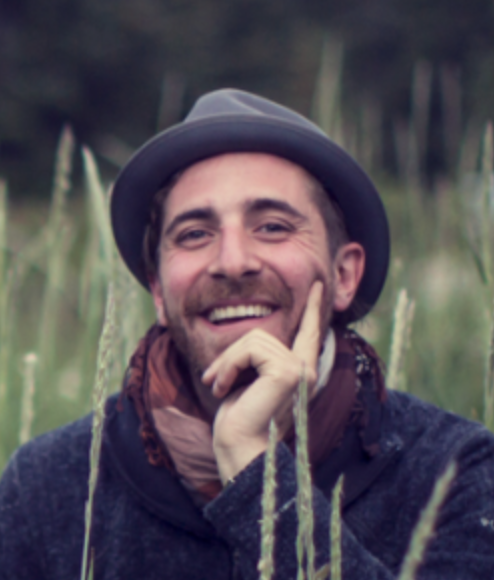 Breedlove
Breedlove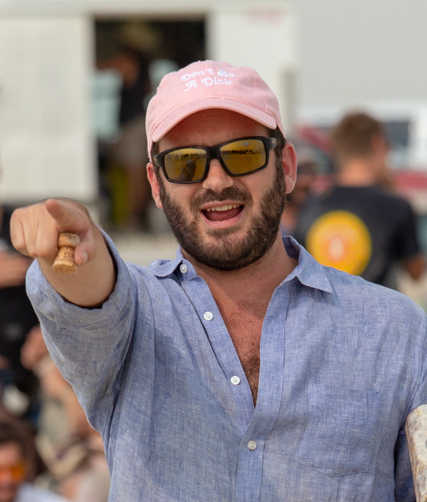 Charlie
Charlie Claire
Claire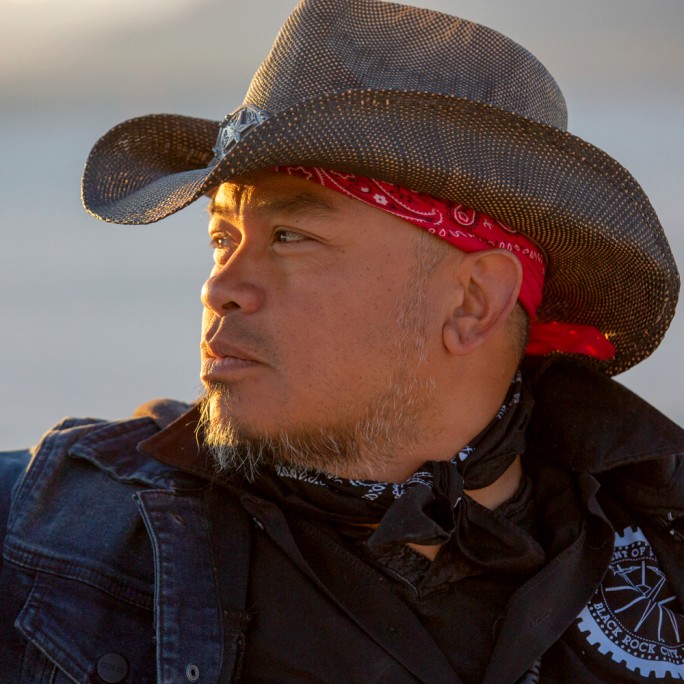 DA
DA Marian
Marian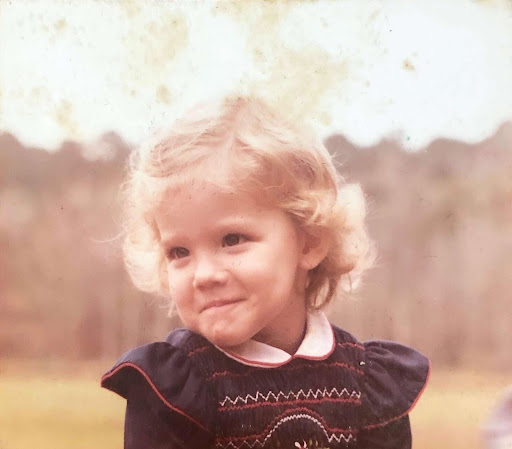 Trixxie
Trixxie Yeti
Yeti







